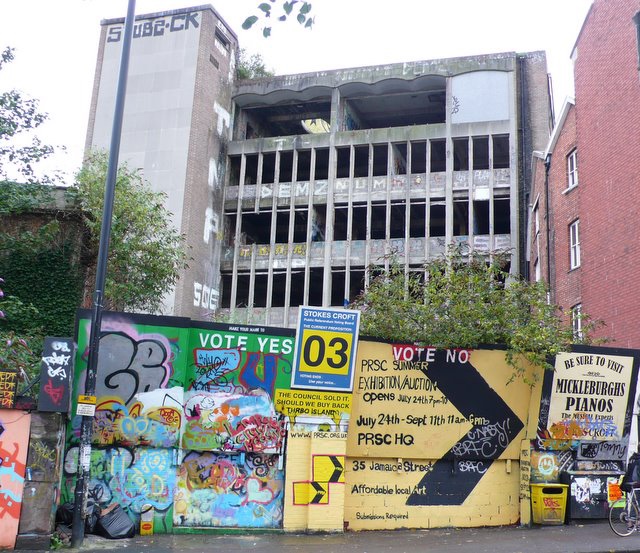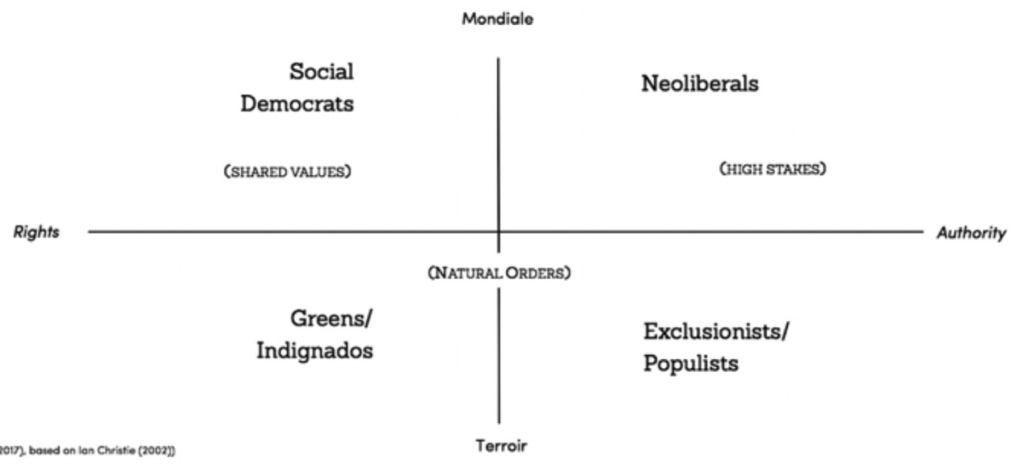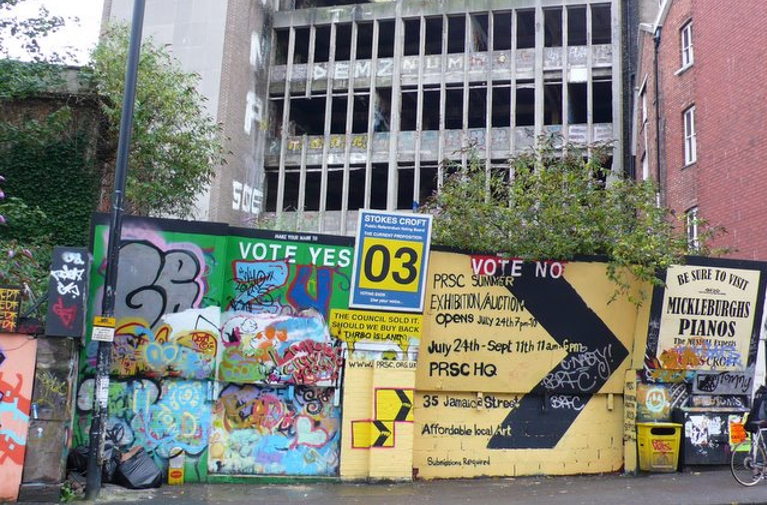In 2017 I wrote a long piece in the Journal of Futures Studies that argued that we were seeing a new “politics of place”, based on the increasing concentration of economic value in cities, and the changing way in which labour markets worked. Watching the uneven and backward looking quality of much of the political analysis that followed last week’s British election results, it seemed worth sharing part of that article here. I’ve made some small trims to remove specifically topical references.

Public Democracy, Stokes Croft Bristol. Image: Nigel Mykura / CC BY-SA 2.0
Cracking apart
One of the biggest current problems with our politics is that the political systems that emerged in the first part of the 20th century, and which dominated the long post-war boom, have now cracked apart, but new systems have not yet taken their place. The process of adaptation, though, has evolved faster in places with more proportional electoral systems.
On the left, the traditional social democratic parties of the centre-left have been disabled by the collapse of the post-war boom and the steady decline of the labour movement. There are good reasons for this. As Hilary Wainwright summarised,
“the world of a mixed economy, where the profits of a productive capitalist sector could be taxed and redistributed to provide universal welfare, social security and a public infrastructure for the benefit of all, no longer exists.”
The collapse of that world shunted all of our mainstream parties towards neoliberal views of the world, some more whole-heartedly than others. While neoliberalism is a contested term, we can follow Will Davies’ work in characterising it as form of politics in which state actors follow a “modernising” agenda that broadens the scope of markets, using the rhetoric of “competition” to target institutions that lie outside of the market, and to marketise or abolish them.
Both conservative and centre-left parties adopted versions of neoliberal policies in the 1990s and beyond, as seen in the rise of the concept of “New public management”.
The changing political landscape
In a paper published in Open Democracy in 2002 Ian Christie described three political scenarios: a squeezed “shared values” world of social democracy; a “high stakes” neoliberal world which produced losers as well as winners; and the emergence, or perhaps re-emergence, of parties based on what he called “natural orders.”
Christie characterised the ‘natural orders’ groups as spanning
“both left and right in the traditional classification of political alignments: it contains protests by local and national interests against the homogenising, top-down capitalist forces that are shaping the values, tempo, environments and organisation of modern societies. What links all of them is the non-Enlightenment view that there are natural limits or imperatives that science, progress and secular rational humanism cannot ignore.”
Building on this work a decade and a half later, it is necessary to pull apart the “natural orders” parties of right and left.

Notions of rights
Both are based on place, but while the populist versions are based on authority, the left versions (for example: Greens, Podemos, the Momentum element in the British Labour Party, the early Syriza, and so on) are constructed around notions of rights. This can even be thought of as a literal construction, of the right to the city, and of the occupations of public space that marked the indignados, nuit debout and the Occupy movement.
And every political debate about migration has at its heart a person and a place, a place where they are either permitted or excluded. In other words, the whole centre of political gravity is in the process of moving from the top of the chart, where labour (top left) contested with capital (top right) the share of an expanding global economy, to the bottom of the chart, where the division is about differences in place and values.
The current arguments in the British Labour Party, for example, are between those looking back to versions of the party above the line, and new activists who look at a “natural orders” version of the party. Some of the most successful parties in the bottom left quadrant have combined progressive politics with a nationalist agenda, such as the Scottish Nationalists or Together for Yes in Catalunya.
[Update: And looking at this through the lens of any of the UK’s recent elections—from 2019 onwards—it is clear that the Conservatives have managed the transition from Neoliberals to Exclusionary Populists and hardly broken stride, and that the championing of Brexit has been the engine for that.]
Money and energy
In short, then, we are moving to a new form of political alignment based on geography rather than social class. The expression of this political alignment is about forms of identity, but its base is in the realignment of the productive economy around the city. This is where the money is, and because of the strong age cohort effects associated with the emerging post-materialist values, this is also where the energy is.
What are the implications of this for a future politics? The transition from a crisis is always ugly. It has become a crisis because previously accepted economic and political arrangements have broken down, and the social agreements that underpinned them are now contested. Nonetheless, it is possible to see some emerging themes.
- Demographics coupled with a deep shift in values suggest that in the medium term politics will be fought out over identity issues. Sara Robinson argued in 2016 that the Sanders presidential campaign, which attracted disproportionate support from younger people, may have been four years too early. In the UK, given the age profiles of Remain and Leave voters, the 2016 referendum probably represented the last chance that Leavers had of winning such a referendum. While American and British politics have recently featured radical campaigns staffed by young people and led by figures with their political roots in the 1970s it is only a matter of time before a Millennial political leader breaks through who is able to link this younger base with the language of a 21st century politics.
- Existing political parties with an older base will continue to manipulate the electoral system, legally and less legally, to delay the moment when they are overtaken by demographics. In the UK, existing and proposed changes to voter registration have the effect of making it harder for younger and poorer people to vote. In the U.S., gerrymandering of electoral boundaries will continue, along with anti-democratic practices designed to suppress voting. So will policies designed to benefit older citizens, who are more likely to vote, at the expense of younger ones. But how long for? As the Millennials and Centennials take their political moment, such studied inter-generational discrimination will be harder to maintain and harder to justify.
- Some parts of some governments will try to shore up the neoliberal agenda, but they will have decreasing success. By “neoliberal agenda,” I mean political attempts to benefit corporations by the continuing marketisation and financialisation of public assets and public services. It’s possible that the EU’s political survival might depend on it moving away from the Lisbon agenda, since its emphasis on “competitiveness” and growth, with related pro-business behaviour, is one of the features that drains political support and permits populist and nativist politicians within its borders to flourish.
- What happens over time to the declining number of voters in the “cultural backlash” group? This is a political question. It is possible to think that the populist moment is likely to peak a decade after the crisis, as Funke et al have argued. Some policies supported by urban progressives should also appeal to younger voters outside of the urban core: obvious steps include improving the quality of labour markets, reducing financialisation, increasing mobility, and increasing trust in governance. Ageing will change the balance around cultural expectations as well. But without some acknowledgement by political actors and institutions of their interests, there is likely to be greater confrontation and political violence, as Peter Turchin suggests.
- Alliances of cities will bypass national governments to promote more progressive agendas that are more aligned with the values both of their citizens and their business leaders. The C40 group of cities is an early example of this. At the same time, these alliances are likely to broaden beyond the current group of “global cities,” and for this reason. There are many signs that the largest cities in the richer world have reached their peak; housing costs are too high for young people to settle, and rents discourage diversity and cultural experimentation and renewal. But the likely beneficiaries are cities with decent local labour markets that have not peaked; in the UK, for example, this might include Bristol, Manchester, or Leeds. Indeed, expect to see this become a standard urban development strategy. The effect, though, will be to make these urban alliances broader and deeper.





